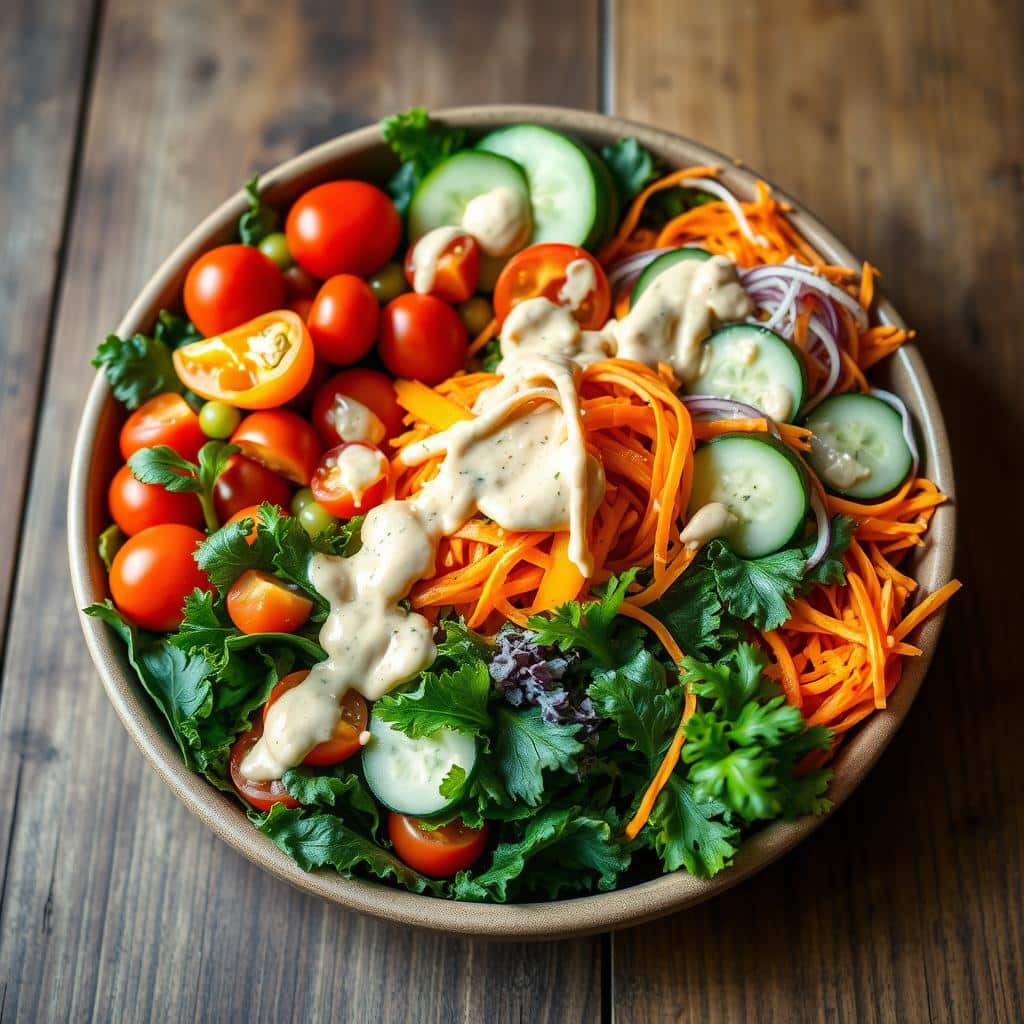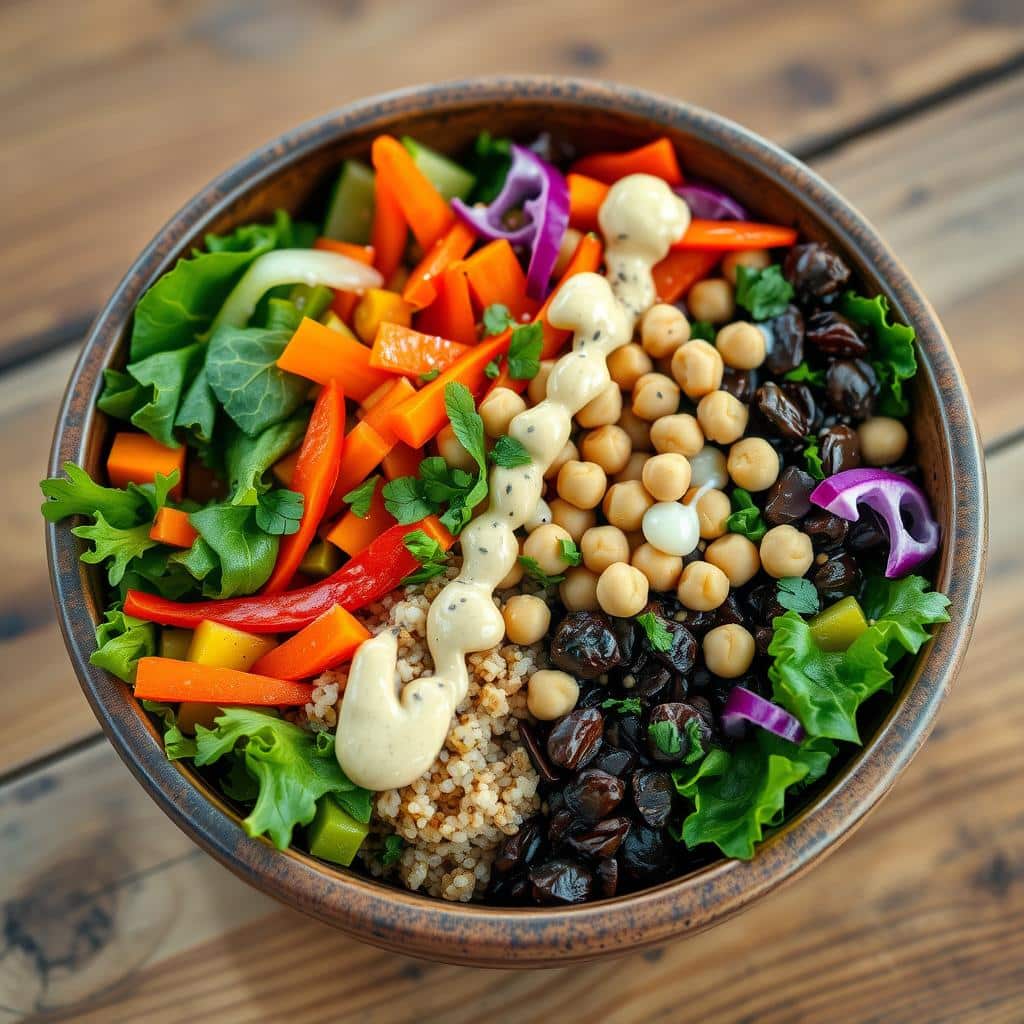I’ve always loved plant-based eating, and the Buddha bowl is a favorite. It’s full of fresh veggies, grains, and protein. This mix of flavors and textures makes you feel great.
Today, I want to share my favorite vegetarian Buddha bowl recipe. It comes with a creamy tahini dressing. This dressing will make your taste buds dance and your body happy.
Key Takeaways
- Discover the origins and cultural significance of the Buddha bowl
- Explore the benefits of incorporating a Buddha bowl into your plant-based diet
- Learn the essential components that make up a nutritious and satisfying Buddha bowl
- Uncover the key ingredients and preparation techniques for a vegetarian Buddha bowl with tahini dressing
- Discover the must-have kitchen tools and equipment to make assembling your Buddha bowl a breeze
Understanding the Buddha Bowl: A Perfect Plant-Based Meal
The Buddha bowl, also known as a power bowl or nourish bowl, is a favorite for those who love plant-based meals. It combines the best of wholesome grains, vibrant veggies, and plant-based proteins. This dish comes from different cooking traditions, making it a hit worldwide.
Origins and Cultural Significance
The Buddha bowl’s roots are in Zen Buddhist monks’ meals. They would mix seasonal foods in one bowl for a healthy, mindful meal. Today, it’s a global dish, blending many flavors and textures.
Benefits of Buddha Bowl Dining
- Promotes a balanced, nutrient-dense diet rich in wholesome grains, vibrant veggies, and plant-based proteins
- Supports overall health and well-being with a focus on whole, unprocessed foods
- Encourages mindful eating and a deeper appreciation for the flavors and textures of plant-based cuisine
- Versatile and customizable to accommodate various dietary preferences and restrictions
Essential Components of a Buddha Bowl
A Buddha bowl is all about balance. It includes:
- Wholesome grains (such as quinoa, brown rice, or farro) to provide complex carbohydrates and fiber
- Vibrant vegetables (ranging from leafy greens to roasted root veggies) for a nutrient-dense foundation
- Plant-based proteins (like tofu, chickpeas, or lentils) to support muscle recovery and overall well-being
- Flavorful toppings and sauces (such as a creamy tahini dressing) to tie the dish together

By choosing and mixing these key elements, you make a Buddha bowl. It’s not just tasty but also packed with nutrients your body needs.
Essential Ingredients for Your Vegetarian Buddha Bowl with Tahini Dressing
Making a tasty vegetarian Buddha bowl begins with picking the right ingredients. It’s all about vibrant veggies, healthy grains, and a creamy tahini dressing. This mix creates a dish that’s both nourishing and delicious. Whether you’re new to vegetarian buddha bowl with tahini dressing or a seasoned fan, knowing the key ingredients is crucial.
Veggie Variety
The magic of a Buddha bowl is its colorful veggies. Here are some favorites:
- Leafy greens (spinach, kale, arugula)
- Cruciferous veggies (broccoli, cauliflower, Brussels sprouts)
- Root vegetables (roasted sweet potatoes, beets, carrots)
- Fresh herbs (cilantro, parsley, basil)
Protein-Packed Powerhouses
To make your vegetarian buddha bowl with tahini dressing a full meal, add plant-based protein. Here are some tasty choices:
- Tofu or tempeh
- Legumes (chickpeas, lentils, black beans)
- Quinoa or farro
- Roasted nuts and seeds
The Creamy Tahini Dressing
No vegetarian buddha bowl with tahini dressing is complete without creamy tahini dressing. This sauce, made from sesame seeds, adds a rich, nutty taste.

With these key ingredients, you’re ready to make a nourishing and vegan-friendly Buddha bowl. Feel free to mix and match veggies, proteins, and tahini dressing. This way, you’ll enjoy a meal that’s both satisfying and balanced.
Kitchen Tools and Equipment Needed
To make a tasty and healthy plant-based dish like a vegetarian Buddha bowl, you need the right tools. From essential utensils to optional gadgets, we’ll cover what you need. These tools will make cooking easier and help you make a great plant-based cuisine and nutritious meal.
Must-Have Utensils
- Sharp chef’s knife: A good knife is key for cutting your veggies.
- Cutting board: Pick a strong, non-slip board for safe chopping.
- Mixing bowls: Different sizes of bowls help mix ingredients easily.
- Measuring cups and spoons: Accurate measurements are crucial for flavor balance.
- Spatula: A sturdy spatula is great for cooking and moving food.
Optional Kitchen Gadgets
While the basics are important, some gadgets can make things easier. Here are some optional tools for your vegetarian Buddha bowl:
- Food processor: It quickly chops or purees veggies, saving time.
- Mandoline slicer: For even, thin veggie slices, a mandoline is a big help.
- Spiralizer: It turns veggies into long, noodle-like strands for a cool texture.
- Instant-read thermometer: It ensures your food is cooked just right.
With the right tools, you’ll be ready to cook your plant-based cuisine and nutritious meal smoothly and efficiently.
Preparing the Perfect Base: Wholesome Grains Guide
Building a tasty plant-based cuisine starts with wholesome grains. These nutritious meal parts give a solid base. They also add texture and flavor to your Buddha bowl. Let’s dive into cooking and preparing different wholesome grains to make your Buddha bowl better.
Quinoa, a versatile supergrain, becomes light and fluffy when cooked right. To get the best quinoa base, use 1 cup quinoa to 2 cups liquid, like water or broth. Boil the mix, then lower the heat and simmer for 15-20 minutes. This makes the quinoa tender and absorbs all the liquid.
Brown rice is great for a heartier base. It has a nutty flavor and chewy texture. Brown rice goes well with the colorful veggies and creamy dressings in your Buddha bowl. Use 1 cup brown rice to 2.5 cups liquid, cooking for 45-50 minutes until it’s tender.
| Grain | Liquid Ratio | Cooking Time |
|---|---|---|
| Quinoa | 1 cup : 2 cups | 15-20 minutes |
| Brown Rice | 1 cup : 2.5 cups | 45-50 minutes |
| Farro | 1 cup : 3 cups | 30-35 minutes |
Farro, an ancient grain, is also great for your Buddha bowl. Cook farro with 1 cup grains to 3 cups liquid, simmering for 30-35 minutes until it’s tender.
The secret to great wholesome grains is finding the right liquid and cooking time. Try different ratios and methods to find what you like best. This will take your plant-based dishes to the next level.
Crafting the Creamy Tahini Dressing
Make your vegetarian Buddha bowl even better with a homemade creamy tahini dressing. This vegan-friendly sauce brings a nutty taste and smooth texture. Learning how to make tahini dressing is key to a great meal.
Selecting Quality Tahini
The best tahini dressing starts with top-notch tahini. Look for tahini from high-quality, toasted sesame seeds. Choose a brand that’s creamy and has a rich, nutty smell. Stay away from gritty or bitter tahini, as it can ruin the dressing.
Mixing Techniques for Smooth Results
- Begin by mixing tahini with lemon juice, garlic, and a bit of salt in a bowl.
- Slowly add water, a tablespoon at a time, until it’s creamy.
- For an even smoother dressing, blend it in a blender or food processor.
Storage Tips for Homemade Dressing
Your creamy tahini dressing can stay fresh in the fridge for up to 1 week. Always stir it well before using, as it might separate. You can also freeze it for up to 3 months.
Follow these tips to make a delicious creamy tahini dressing. It will take your vegetarian Buddha bowl to the next level. Enjoy your vegan-friendly dish!
Vibrant Vegetables: Preparation and Cooking Methods
To make your vibrant veggies shine, focus on creating a delicious plant-based cuisine. Try roasting, steaming, sautéing, or eating them raw. These methods will turn your nutritious meal into a feast for the eyes and taste buds.
Roasting Vegetables
Roasting veggies makes them sweet and flavorful. Mix cubed or sliced veggies with olive oil, salt, pepper, and herbs. Then, roast at 400°F until they’re tender and golden.
Steaming for Vibrant Texture
Steaming is great for keeping veggies vibrant and crunchy. Place them in a steamer basket and steam for 5-7 minutes. This way, they stay fresh and full of color.
Sautéing for Flavorful Veggies
Sautéing quickly enhances the taste of your vegetables. Heat oil in a skillet, add the veggies, and cook over medium-high heat. They’ll be tender and slightly charred.
Raw Veggie Preparation
For a burst of freshness, serve some vibrant veggies raw. Shred, slice, or spiralize your favorites. Then, toss them with tahini dressing for a healthy, light touch to your plant-based cuisine.
| Cooking Method | Flavor and Texture | Recommended Veggies |
|---|---|---|
| Roasting | Caramelized, intensified flavors | Carrots, Brussels sprouts, cauliflower, sweet potatoes |
| Steaming | Tender, crisp-tender texture | Broccoli, green beans, snow peas, asparagus |
| Sautéing | Flavorful, slightly charred | Mushrooms, bell peppers, zucchini, onions |
| Raw | Refreshing, crunchy | Cabbage, carrots, radishes, cucumbers |
Learning these vibrant veggie cooking methods will help you create stunning and nutritious meals. Your plant-based cuisine will be a feast for the eyes and taste buds.
Protein-Rich Additions for Your Bowl
Creating a delicious vegetarian Buddha bowl means adding protein-rich ingredients. This makes your meal satisfying and nutritious. Luckily, there are many plant-based protein options to enhance your dish.
Plant-Based Protein Options
- Tofu: This versatile soy-based ingredient can be marinated, baked, or sautéed. It adds a boost of vegan-friendly protein to your bowl.
- Tempeh: Made from fermented soybeans, tempeh has a heartier texture and a nutty flavor. It pairs well with your Buddha bowl.
- Legumes: Beans, lentils, and chickpeas are great sources of nutritious meal protein. They’re easy to add to your dish.
- Nuts and Seeds: Almonds, walnuts, sunflower, and pumpkin seeds are crunchy and protein-rich. They add a satisfying punch to your bowl.
Preparation Techniques
To make your plant-based proteins stand out in your Buddha bowl, try these preparation techniques:
- Marinate tofu or tempeh in a flavorful sauce or dressing. This infuses them with delicious seasonings.
- Roast or sauté legumes, nuts, and seeds. This brings out their natural flavors and crisp textures.
- Try different cooking methods like pan-frying, baking, or air-frying. This creates a variety of textures and tastes.
By using a mix of plant-based protein options and creative cooking methods, you can make a vegetarian Buddha bowl. It will look great and be full of nutrients to fuel your body and please your taste buds.
Assembly Tips and Presentation Techniques
Making a vegetarian Buddha bowl with tahini dressing is like creating art. To make your dish stand out, try these tips. They will highlight your vibrant veggies beautifully.
Layering for Visual Appeal
Begin with a base of grains like quinoa or brown rice. Next, arrange your veggies in a pattern that catches the eye. For example, place roasted sweet potatoes on one side, steamed broccoli in the middle, and fresh spinach on the other.
Contrasting Textures and Colors
Make your Buddha bowl pop with different textures and colors. Mix crunchy raw veggies with soft cooked ones. For instance, add raw carrots and radish with sautéed mushrooms or roasted beets. The mix of colors, like purple cabbage and green kale, will wow your guests.
Thoughtful Garnishing
Top your Buddha bowl with garnishes that boost flavor and look. Drizzle tahini dressing, then sprinkle sesame seeds, herbs, or za’atar. These touches will not only taste great but also look amazing on Instagram.
| Presentation Technique | Description |
|---|---|
| Layering | Arrange ingredients in visually appealing layers to create depth and texture. |
| Contrasting Textures | Combine crunchy and soft elements for a dynamic mouthfeel. |
| Vibrant Colors | Utilize a variety of colorful vegetables to make the dish visually stunning. |
| Thoughtful Garnishing | Add finishing touches like dressings, seeds, and herbs to elevate the presentation. |
With these tips, your vegetarian Buddha bowl will become a masterpiece. It will look great and taste even better.
Make-Ahead and Storage Solutions
Preparing your plant-based meals ahead of time can be a big help. It makes it easier to enjoy a healthy meal even when you’re busy. By learning how to prep and store your vegetarian Buddha bowl ingredients, you can make quick and tasty bowls all week long.
Meal Prep Strategies
Here are some tips to start your Buddha bowl meal prep:
- Cook grains like quinoa or brown rice early and keep them in the fridge for up to 5 days.
- Chop veggies like carrots, bell peppers, and cucumbers, and store them in airtight containers for easy bowl assembly.
- Prepare proteins like roasted chickpeas or baked tofu, and keep them in the fridge for easy bowl additions.
- Make a big batch of tahini dressing and portion it out for easy serving.
Storage Guidelines
Storing your Buddha bowl ingredients right is important. It keeps them fresh and ready to eat. Here’s how to do it:
- Grains: Store cooked grains in an airtight container in the fridge for up to 5 days.
- Vegetables: Keep washed and chopped veggies in the fridge in sealed containers or bags for up to 4 days.
- Proteins: Refrigerate plant-based proteins, like roasted chickpeas or baked tofu, for up to 4 days.
- Tahini Dressing: Store the homemade tahini dressing in an airtight container in the refrigerator for up to 7 days.
By using these meal prep and storage tips, you can enjoy a healthy plant-based meal anytime. You won’t have to start from scratch.
Conclusion
The vegetarian Buddha bowl with tahini dressing is a meatless delight. It shows the beauty and versatility of plant-based food. By mixing wholesome grains, nutrient-dense veggies, and a creamy dressing, you’ve made a meal that’s good for you.
If you’re a vegetarian or just want to eat less meat, the Buddha bowl is perfect. You can change up the ingredients to try new flavors and textures. This makes every bowl special and unique to you.
Keep exploring the vegetarian Buddha bowl and have fun with it. Try different grains, veggies, and proteins to make your own dish. With a bit of creativity, you’ll enjoy this nutritious meal over and over again.
FAQ
What is a Buddha bowl?
A Buddha bowl is a healthy meal filled with plants. It has grains, colorful veggies, and protein. It looks good and tastes great.
What are the typical ingredients in a Buddha bowl?
A Buddha bowl starts with grains like quinoa or brown rice. It also has veggies and a protein source, like tofu. A creamy tahini dressing adds flavor.
What are the benefits of eating a Buddha bowl?
Buddha bowls are packed with nutrients. They’re full of vitamins, minerals, and antioxidants. They make you feel full and support your health.
Can I customize the ingredients in a Buddha bowl?
Yes, you can make a Buddha bowl your own. Try different grains, veggies, proteins, and dressings. Find what you like best.
How do I prepare the tahini dressing for the Buddha bowl?
To make the tahini dressing, mix tahini, lemon juice, and garlic. Blend until smooth. You can adjust the flavors to taste.
Can I make the Buddha bowl components in advance?
Yes, you can prep many parts of a Buddha bowl ahead. Cook grains, prep veggies, and make the dressing. Then, assemble and enjoy a healthy meal.

